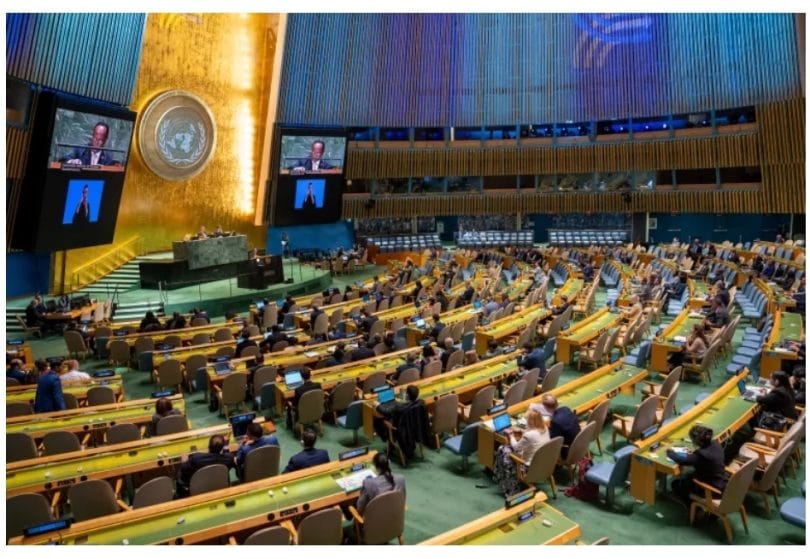The Summit of the Future presents a rare opportunity for transformative change, offering a platform to commit to innovative solutions. It aims to create international frameworks that better address the realities of the 21st century, preparing us for today’s and future challenges. As a global community, we are responsible for charting a better course. Collaboration can build a more peaceful, just, inclusive, sustainable, and prosperous future.
The General Assembly adopted the Pact for the Future Resolution, accompanied by the Global Digital Compact and the Declaration on Future Generations.
This ambitious pact, adopted by the United Nations General Assembly (UNGA), seeks to revitalise the UN’s relevance and effectiveness in the 21st century despite ongoing criticism over its ability to prevent conflicts and hold violators accountable.
While Russia and Iran were among seven countries opposing the “Pact for the Future,” they could not prevent its adoption during the summit, which took place on Sunday and Monday.

What is the Pact for the Future?
The UN describes this pact as a “landmark declaration” aimed at improving the future for generations to come. The document emphasises faster progress toward the Sustainable Development Goals (SDGs) and Paris Agreement commitments on climate change. It also pledges to address the root causes of conflicts and accelerate progress on human rights, particularly women’s rights.
Two annexes support the pact: the Global Digital Impact, which focuses on regulating artificial intelligence (AI), and the Declaration on Future Generations, which advocates for policies that secure the well-being of future generations.
“We are here to bring multilateralism back from the brink,” said UN Secretary-General Antonio Guterres, emphasising the need for agreement and action.

According to Richard Gowan, UN Director at the Crisis Group, the pact covers various issues with varying degrees of ambition. Some initiatives, such as reviewing UN peacekeeping operations, are more actionable, while goals like nuclear disarmament are largely symbolic.
Does the pact outline a clear path to achieving its goals?
Not entirely. Like many UN resolutions, the Pact for the Future is filled with lofty ambitions but needs more specific steps for implementation. It promises to end hunger, address global financial gaps, achieve gender equality, and protect the environment, yet it provides little detail on how these goals will be achieved.
As conflicts in Gaza, Ukraine, and Sudan persist, the pact reaffirms the UN’s support for the International Court of Justice (ICJ). However, it does not clarify how the organisation will ensure compliance with its rules, particularly in cases like Israel’s ongoing conflict in Gaza.
The pact also reiterates commitments to disarmament and restoring trust in global institutions by making them more representative, particularly for Africa, Asia Pacific, and Latin America. However, it does not offer concrete steps to realise these reforms.
Additionally, it calls for reforming international financial systems, enhancing responses to global crises, and improving cooperation in outer space. However, major space-faring nations with veto power in the UN Security Council (UNSC) remain shielded from significant accountability.
While the pact aims to strengthen the UNSC’s response and revitalise the work of the UN General Assembly, it lacks specific mechanisms for doing so.
Gowan notes that although many developing countries played a more significant role in shaping the pact than in previous UN reform processes, powerful nations like the U.S. still maintained their influence over critical issues, such as the financial system.
“The pact may not be perfect and lacks the urgency needed to address the global crises we face,” Gowan says. “But in today’s bleak geopolitical environment, the fact that diplomats reached any agreement is a positive step.”
Why was there opposition?
Countries like Russia, Iran, North Korea, and Syria expressed concerns over national sovereignty and external intervention. They proposed an amendment emphasising that the UN should not interfere in the domestic affairs of member states.
Russia’s Deputy Foreign Minister Sergey Vershinin accused Germany and Namibia, who coordinated the pact, of pushing a Western agenda and disregarding Russia’s calls for intergovernmental negotiations. While Russia distanced itself from the document, the Republic of Congo and Mexico rejected its proposed amendments, allowing the pact to proceed.
According to Gowan, Russia miscalculated its position and faced a public defeat when it failed to withdraw its amendment. Despite its concerns, the pact moved forward with broad international support.








